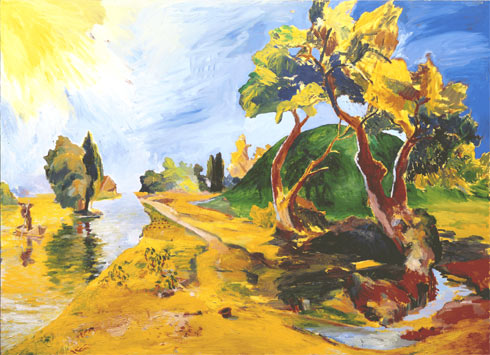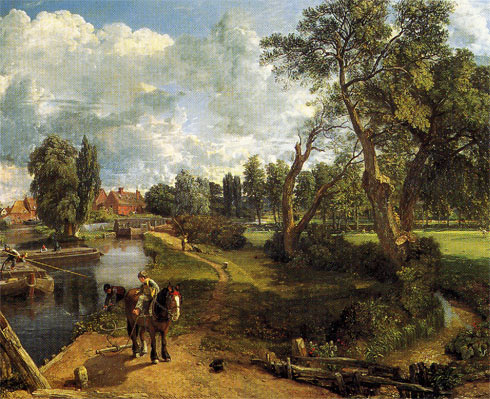The Embarkation to Cythera, Modern Art with Pompoms
Amitai Ben David, The Embarkation to Cythera 1991, 102x140cm, Oil on canvas (Photo: Ernest Moritz)
John Constable, Flatford Mill 1817, 101.7x121cm, Oil on canvas, Tate gallery, London UK.The first group of paintings that I will discuss were made between 1991 and 1992, the years that followed my graduation from the Den Bosch Royal Academy of Visual Arts. Upon graduation, in 1991, I continued to live in Den Bosch, a provincial conservative town in the south of the Netherlands, where the art academy was located. Life in Den Bosch had turned rather unpleasant for me, an undercurrent sentiment of resentment against foreigners, a sentiment not new to northern Europe, but suppressed and unexpressed, had come to the surface. Although the more violent demonstrations of these sentiments, incidents of harassment and physical assault, occurred mostly across the border, in France, Belgium and Germany. Holland too, had its share of race-hate crimes. These sentiments reached a tragic peak in 1993 in Solingen, Germany, when four German youths, set fire to the home of a Turkish immigrant family resulting in the death of five family members, including three children. Right wing parties like the Central Democratic Party had gathered increasing support, feeding on a growing xenophobic sentiment in Dutch society. My Semitic features often made me sense antagonistic reactions from Dutch people, at times based on actual xenophobia, while at other times it was just imagined. Being raised in the family of a Second World War survivor has made me strongly fear the evil of race hatred. 1991 was also the year when the first Gulf War broke out. Sitting in my room/studio in Den Bosch, an environment that I felt was getting increasingly racially polarized and unfriendly, and watching anxiously the CNN reports of the war, a war that involved my homeland Israel, made me come to the decision, that it was time to return home. The paintings that I created in that period deal, at times directly, at times as a sub-theme, with issues of immigration, displacement and one’s search for a safe haven. These subjects have become fundamental to my work. Although my mental and artistic dealings with these subjects has changed with the years, my continued existence as a foreigner, in Europe and in later years in Japan, has kept them relevant and personal matters. The Embarkation to Cythera (1991), uses the painting by the English painter John Constable, Flatford Mill (1817) as a founding image. A choice that reflects my fascination, in the early 1990s, with the Romantic movement (late 18th to the mid-19th century), particularly with the work of Henry Fuseli, Casper David Friedrich, J.M.W Turner and John Constable and their later disciple Gustave Moreau. My fascination was naturally with their painterly skills, but even more, I was intrigued with their emphasis on the personal, the spontaneous and their exaltation of emotion over reason, in a certain pathos that from a contemporary viewpoint strangely oscillated between the pompous and the honest, the ridiculous and the bold. I enjoyed very much the confusion that I felt in front of the Romantic images, in one hand dismissing their fancy manners and on the other, struck by the relevancy of their humanistic message and enchanted with their meticulous observations of nature and the splendour of their work. A visit to the Tate museum’s Turner room left a very strong impression on me, and convinced me of the importance of a correspondence with their work and ideas. Unfortunately, this is a one-way correspondence. A dear Professor of my undergraduate training in the Den Bosch art academy, the Dutch painter Rein Dool, has described the creation of art as a constant battle, dialogue, between the in and the out; for him, a successful work of art should balance between the two, the in being the personal, the private, and the out, stands for the reality that surrounds the artist, the structured, the rational, and the laws of communication. A constant dialogue between the chaotic and the ordered, the abstract and the formal, lie in the core of a successful painting: The in and the out he said, whispering the secrets of art. Next to the apprenticeship like nature of the correspondence that I held with the Old Masters, I value the correspondence as a certain in/out dialogue, where my own personal vision and conflicts, bound to a specific time, place, and biography, meet the public, the universal, the eternal. The anonymous artist encounters the canonized, at times yielding to their authority and other times insisting on his own solution. The Embarkation to Cythera is an attempt to integrate in my artistic vocabulary some of the Romantic’s elements, embarking, from an image of John Constable’s classical composition (who based his work, in turn, on Claude Lorain’s ideal of proportion) . The image describes a yellow landscape scene, under expressive blue skies, pierced by beams of yellow light. On the left side of the painting, a boy is rowing a boat, advancing towards the shore. This painting, a dialogue with art history ghosts, Constable’s work and Constable’s landscape, demonstrates the degree of modification that I must bring to another man’s creation in order to construct a space that will allow me to express my personal vision and emotions. I am the painter who paints the painter. Very much like a landscape architect, or just a menace, I enter Constable’s garden with a shovel, and start digging. Moving earth around, creating an artificial hill, expanding the riverbed, changing the climate and expelling the locals, who leave no tracks behind but a forgotten hat. On the narrative level I am not concerned with the reasons that brought Constable to that particular valley in his native England. I am not concerned with the identity of the figures. I feed on his vision of nature, inspired by the rhythm, the mood of the work. But that inspiration is more of a starting point. Constable’s space is a creation of beauty where I enjoy being and working; I am renting a cottage in his estate, taking for myself the liberties to refurnish it. Here starts my story. I am the boy on the boat, returning to my homeland, Israel. (A move that was a few months ahead of me, when this painting was created.) The sun on the left side of the work, painted very much in a child-like way, a simple triangular yellow form, echoes the return to a childhood landscape, the hat that lies on the bank of the river, suggests a return to the past, to a place left in haste. On the yellow banks of the river, burning in Mediterranean sun, I planted flowers and red hot peppers, just like in my aunt’s back yard, and the title, yet another borrowing, from Antoine Watteau’s melancholic creation The embarkation to Cythera of 1717, which depicts a party of noblesse boarding a ship, embarking on the journey for the mythological island of love, Cythera , or if you wish, my own mythological island of longing, Israel. By Amitai Ben David. Extract from the doctoral dissertation: "Fruitful Incoherence; The next village, a personal expedition" |
All contents © Copyright Amitai Ben David 2006-2009. Website by Almost Daily.